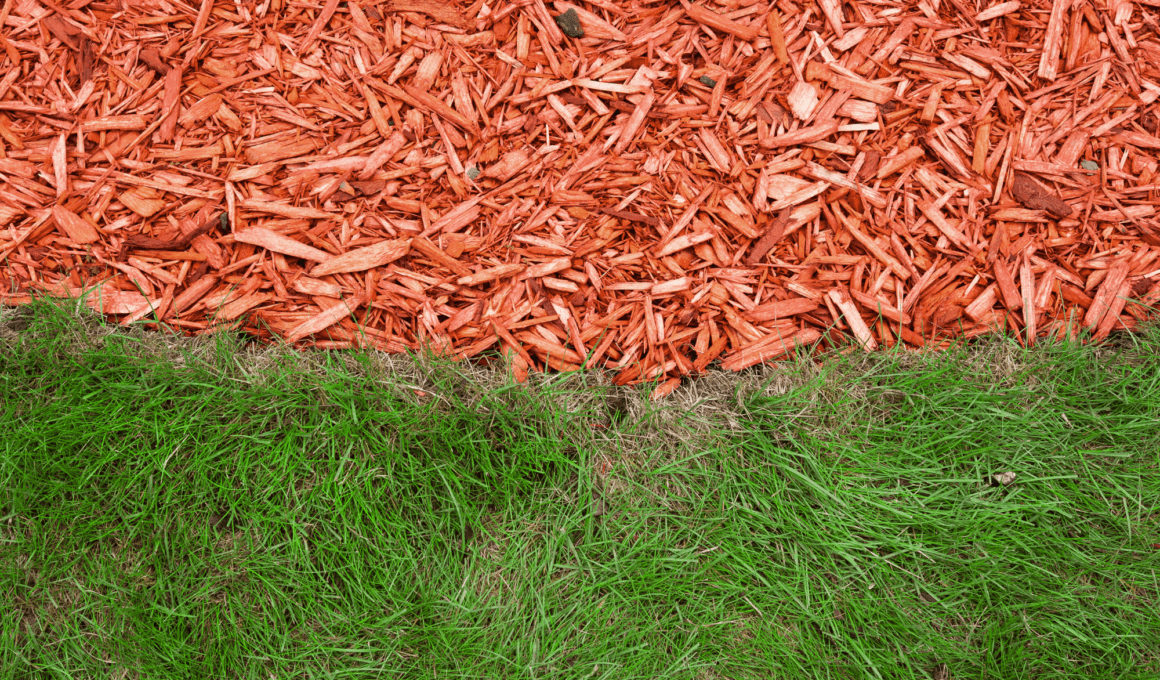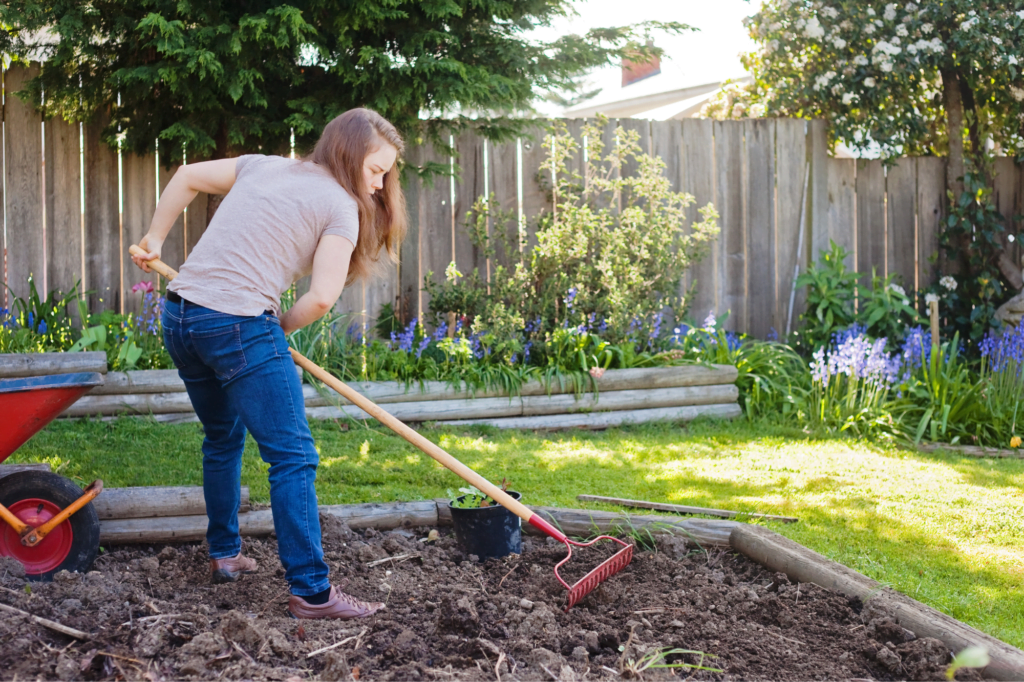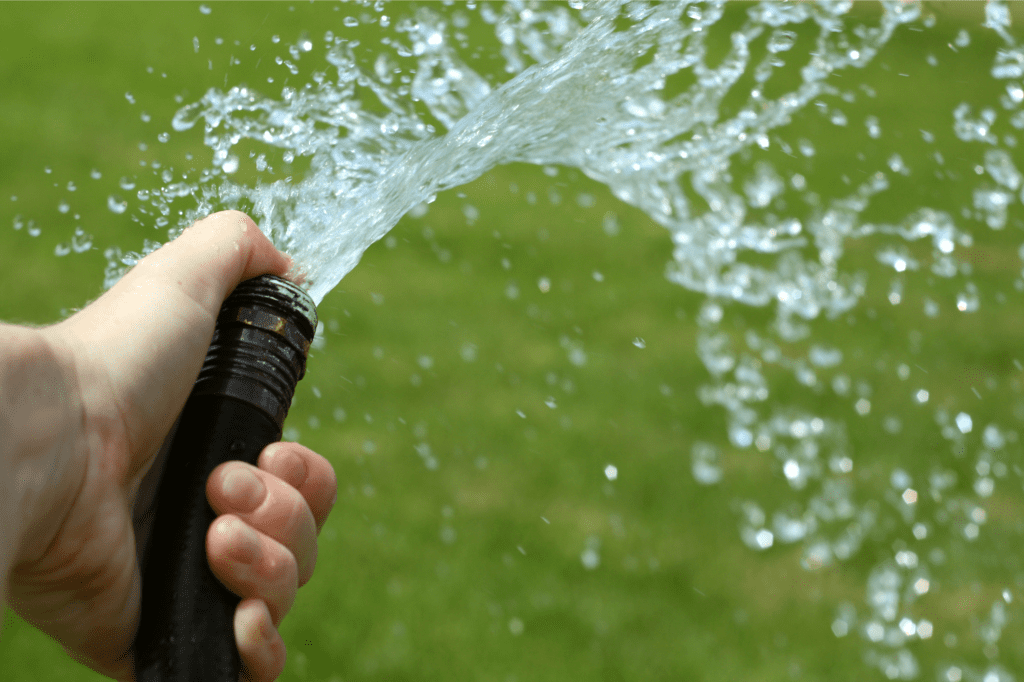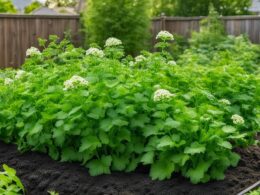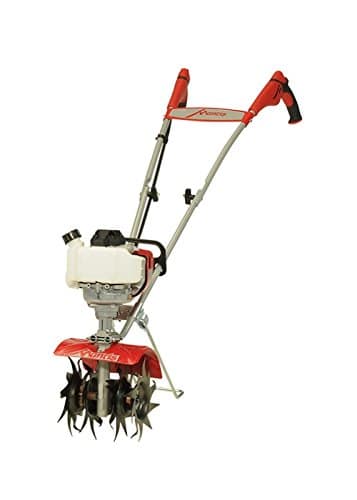Are you tired of the dull and lifeless mulch in your garden? It’s time to transform your outdoor space into a vibrant and lush grassy oasis!
In this article, we will guide you through the process of removing mulch and replacing it with beautiful, green grass.
First, you need to assess your garden’s needs. Determine if the mulch is inhibiting the growth of grass and if it needs to be removed. Once you’ve made that decision, it’s time to prepare the soil by removing any debris and ensuring it is loose and fertile.
Next, choose the right grass seeds that are suitable for your climate and soil conditions. With the seeds in hand, it’s time to seed your lawn, ensuring proper coverage.
After seeding, it’s crucial to water and care for your new grass, providing it with the hydration and nutrients it needs to thrive. Monitor its progress and make any necessary adjustments along the way.
Finally, maintain your grass by regularly mowing, fertilizing, and watering it. With proper maintenance, you’ll soon be able to enjoy your new grassy oasis and create a safe and inviting space for yourself and your loved ones.
Quick Summary
- Assess the garden’s needs before removing mulch and replacing it with grass.
- Prepare the soil by removing debris and ensuring it is loose and fertile.
- Choose the right grass seeds for the climate and soil conditions.
- Water and care for the new grass to promote growth, and monitor its progress for necessary adjustments.
Assess Your Garden’s Needs
You’ll need to take a close look at your garden to figure out exactly what it needs before you can start transforming it into a lush green oasis. Assessing your garden’s condition is the first step towards removing mulch and replacing it with grass.
Start by evaluating the quality of the existing soil. Check for signs of compaction, drainage issues, or nutrient deficiencies. If the soil is in poor condition, you may need to amend it before planting grass.
Next, consider the amount of sunlight your garden receives. Different grass varieties have different sunlight requirements, so it’s important to choose the right type for your garden. If your garden is shady, opt for a shade-tolerant grass variety. On the other hand, if your garden gets plenty of sun, you can choose a grass variety that thrives in full sunlight.
Additionally, think about the amount of foot traffic your garden receives. If you have kids or pets who will be running and playing on the grass, you’ll need a more durable grass variety that can withstand heavy use.
By carefully assessing your garden’s condition and evaluating your lawn options, you’ll be able to choose the best grass variety and prepare your garden for its transformation into a beautiful green space. Remember to prioritize safety by wearing gloves, sturdy shoes, and using appropriate tools when working in your garden.
Prepare the Soil
To prepare the soil for grass, you’ll need to start by removing the existing mulch. Use a rake or shovel to loosen the soil and remove any debris such as rocks or roots.
This will create a clean and level surface for the grass to grow.
Remove existing mulch
First, let’s get rid of that old mulch and make way for a lush carpet of grass. To safely remove the existing mulch, start by using a rake or shovel to loosen and lift it away from the soil. Be careful not to damage any nearby plants or roots in the process. You can also consider using a leaf blower to blow away loose mulch, making the removal easier.
Once the majority of the mulch is removed, use a garden hose or pressure washer to wash away any remaining debris. Removing the old mulch is essential because it allows for better soil aeration and nutrient absorption, promoting healthy grass growth. By replacing mulch with grass, you’ll also enjoy benefits like reduced weed growth, improved soil moisture retention, and a more visually appealing landscape.
Loosen the soil and remove any debris
Get ready to experience a satisfying transformation as you break up the compacted soil and eliminate any lingering debris. Loosening the soil is a crucial step in preparing your lawn for grass. Here’s how to do it safely:
- Grab a sturdy garden fork or a tiller to loosen the soil.
- Work your way across the area, inserting the fork or tiller into the soil and gently rocking it back and forth.
- Be careful not to damage any existing roots or irrigation systems.
- Once the soil is loosened, use a rake to remove any rocks, sticks, or other debris.
By loosening the soil and removing debris, you create a healthy foundation for your new grass to thrive. Remember to wear gloves and protective eyewear throughout the process to ensure your safety.
Choose the Right Grass Seeds
When choosing the right grass seeds, you’ll want to consider the climate and growing conditions in your area. This is crucial for ensuring successful grass growth and a lush, green lawn.
Start by researching the types of grass that thrive in your specific climate. Some grasses are better suited for cooler temperatures, while others can withstand the heat. It’s also important to take into account the amount of sunlight your lawn receives. Some grasses require full sun, while others can tolerate shade.
Once you have identified the appropriate grass seeds for your area, it’s time to prepare the soil for grass growth. Begin by loosening the soil with a garden fork or tiller. This will help to break up any compacted soil and allow the grass roots to penetrate deeper. Remove any debris such as rocks, sticks, or old mulch that may interfere with grass growth.
Next, you’ll want to amend the soil with organic matter such as compost or peat moss. This will improve the soil’s fertility, drainage, and overall health. Spread a layer of the organic matter over the loosened soil and use a rake to incorporate it evenly.
By choosing the right grass seeds and preparing the soil properly, you’ll set the stage for a thriving lawn. Remember to water the newly planted seeds regularly and provide them with proper care to ensure their growth and development.
Seed Your Lawn
Create a beautiful, vibrant lawn by sowing the perfect grass seeds for your area and watch your dreams of a lush green oasis come to life. To ensure a successful lawn renovation, follow these steps:
- Prepare the soil: Before seeding your lawn, it’s crucial to prepare the soil properly. Remove any debris, rocks, or weeds from the area. Loosen the soil with a rake or a tiller to create a smooth surface for the seeds to establish.
- Choose the right grass seeds: Select grass seeds that are suitable for your climate and soil conditions. Consider factors such as shade tolerance, drought resistance, and maintenance requirements. Consult with a local nursery or extension office for expert advice.
- Seed your lawn: Spread the grass seeds evenly across the prepared soil. Use a seed spreader for larger areas or simply broadcast the seeds by hand for smaller patches. Lightly rake the seeds into the soil, ensuring good seed-to-soil contact.
Lawn maintenance is essential for the long-term health and beauty of your newly seeded lawn. Water your lawn regularly, keeping the soil moist but not saturated. Avoid walking on the grass until it has established roots. Once the grass reaches a height of around three inches, mow it to promote healthy growth. Regularly fertilize and aerate the lawn to keep it healthy and thriving.
By following these steps, you can achieve a vibrant, well-maintained lawn that’ll be the envy of your neighborhood.
Water and Care for Your New Grass
To ensure the health and vitality of your newly planted grass, it’s crucial that you properly water and care for it. Grass watering is essential in the early stages of growth. After seeding your lawn, you should water the area lightly every day for the first two weeks. This will help the seeds germinate and establish strong roots. Be sure not to overwater, as this can lead to shallow root development and disease.
Once your new grass starts to grow, you can reduce the frequency of watering. Water deeply, but infrequently, to encourage deep root growth. This will make your grass more resilient and drought-resistant. Aim for about an inch of water per week, either through rainfall or irrigation.
In addition to proper grass watering, it’s important to care for your new grass. Avoid mowing until the grass reaches a height of at least three inches. This allows the roots to establish themselves fully. When you do start mowing, set the blade height to around two to three inches. This will promote healthy growth and shade the soil, preventing weed growth.
Remember, the key to a lush and vibrant lawn is consistent grass watering and proper care. By following these guidelines, you’ll be well on your way to enjoying a beautiful, healthy yard.
Monitor and Adjust as Needed
Keep an eye on how your grass is growing and make sure to monitor its progress regularly. Adjust your watering and care routines as needed to ensure your grass is getting the right amount of moisture and nutrients.
By staying vigilant and making necessary adjustments, you can promote healthy growth and maintain a lush, vibrant lawn.
Keep an eye on your grass’s growth
Watch as your grass begins to sprout and reach for the sunlight, transforming your yard into a vibrant green oasis. It’s important to monitor the growth of your grass to ensure its health and vitality.
Keep an eye out for signs of healthy grass growth, such as even and consistent growth patterns, vibrant green color, and strong root development. Regularly check for any signs of discoloration, thinning, or patchy areas, as these may indicate potential issues that need attention.
As your grass grows, adjust your watering and mowing schedule accordingly to promote optimal growth. Remember to be cautious when using fertilizers or pesticides, following the instructions carefully to avoid any harm to yourself, your family, or the environment.
With careful monitoring and adjustments, your grass will thrive and provide a beautiful backdrop for your outdoor activities.
Make adjustments to watering and care routines
Ensure that your watering and care routines are adjusted accordingly to provide the optimal conditions for your grass to thrive. Start by adjusting your watering schedule. As the mulch is removed and replaced with grass, the water requirements will change.
Monitor the moisture levels in the soil and water accordingly. Overwatering can lead to shallow root growth and diseases, so be mindful not to overdo it.
Additionally, proper lawn care techniques are essential for the health of your grass. Regularly mow your lawn at the appropriate height, usually around 2-3 inches, to promote healthy growth. Remove any weeds that may compete with your grass for nutrients.
Fertilize your lawn according to the recommended schedule to ensure it receives the necessary nutrients. By adjusting your watering and care routines, you’ll create a safe environment for your grass to flourish.
Maintain Your Grass
Maintaining a vibrant and healthy lawn involves regular care and attention. To ensure that your grass stays in optimal condition, it’s important to follow a few key steps.
First, make sure to mow your lawn at the proper height and frequency. This’ll help prevent grass diseases and promote healthy growth.
Additionally, it’s crucial to water your grass deeply and infrequently, rather than giving it frequent shallow waterings. This’ll encourage the roots to grow deeper and make your grass more resistant to drought.
Another important aspect of maintaining your grass is fertilizing it regularly. Choose a high-quality, slow-release fertilizer that’s appropriate for your grass type. Apply it according to the recommended instructions, taking care not to over-fertilize as this can lead to nutrient burn and other problems.
Lastly, be mindful of any signs of pests or diseases in your lawn. Keep an eye out for brown patches, wilted grass, or unusual spotting. If you notice any of these signs, take immediate action to prevent further damage. This may involve using appropriate pest control methods or applying fungicides to prevent the spread of diseases.
By staying vigilant and taking these steps, you can maintain a healthy and vibrant lawn that’ll be the envy of your neighbors.
Enjoy Your New Grassy Oasis
Immerse yourself in the lush, green oasis of your new lawn, where you can relax and unwind in nature’s embrace. Maintaining your new grass is essential to ensure its longevity and beauty.
Regular watering is crucial to keep your grass healthy and vibrant. Water deeply and infrequently to encourage deep root growth and prevent shallow rooting. Avoid overwatering as it can lead to disease and shallow roots.
Mowing your grass at the correct height is also important. Set your mower blades to a height of 2-3 inches to promote healthy growth and discourage weed growth. Be sure to sharpen your mower blades regularly to ensure clean cuts and prevent damage to the grass.
One of the benefits of having grass instead of mulch is the reduced risk of fire. Grass acts as a natural fire retardant, helping to protect your home and property. It also provides a soft and comfortable surface for activities like picnics and playing with children or pets.
Regularly fertilizing your grass will help it stay lush and green. Use a slow-release fertilizer to provide nutrients over an extended period. Be sure to follow the instructions on the fertilizer package for proper application.
By properly maintaining your new grass, you can enjoy the benefits of a beautiful and safe outdoor space. Take pride in your new grassy oasis and create lasting memories with family and friends.
Frequently Asked Questions
How long does it typically take for grass seeds to germinate and start growing?
Grass seeds usually take about 7-21 days to germinate and start growing, but this can vary depending on factors like temperature, moisture, soil quality, and type of grass seed used.
Is it necessary to remove all of the old mulch before seeding the lawn?
Yes, you should remove old mulch before seeding your garden. This allows the grass seeds to have direct contact with the soil, promoting better germination. Properly prepare the soil by removing weeds, loosening it, and adding fertilizer for optimal grass growth.
Can I use a pre-emergent herbicide after seeding the lawn to prevent weeds from growing?
Yes, you can use a pre-emergent herbicide after seeding your lawn to prevent weeds from growing. However, it’s important to consider alternative weed prevention methods that are safe and effective, as the effectiveness of pre-emergent herbicides may vary.
What is the best time of year to remove mulch and replace it with grass?
The best time of year to replace mulch with grass is during the spring or fall when grass growth is at its peak. This ensures that the grass has optimal conditions for establishment and reduces the risk of damage.
Are there any specific lawn care practices I should follow after the grass has fully established?
After your grass has fully established, practice proper lawn maintenance by regularly mowing, fertilizing, and aerating. Use watering techniques such as deep and infrequent watering to promote healthy root growth and prevent disease.
Conclusion
Congratulations on successfully removing the mulch and replacing it with lush green grass!
You’ve taken the necessary steps to assess your garden’s needs, prepare the soil, choose the right grass seeds, seed your lawn, and provide proper care and maintenance.
By monitoring and adjusting as needed, you’ve created a beautiful grassy oasis that you can enjoy.
Keep up the good work and continue to maintain your new grass to ensure its health and longevity.
Cheers to your new green paradise!





